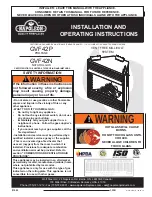
OVERALL APPLIANCE AND CONTROL OPERATION
A normal operating sequence is as follows:
1.
The control determines that the actual water temperature inside tank is 4 degrees F., with the factory set 8 degree F.
differential, below programmed temperature set point;
The control performs selected system diagnostic checks;
If all checks are successfully passed, the combustion blower is energized for the 40 second pre-purge cycle;
During the pre-purge cycle is complete, power is applied to the ignitor element for the ignitor warm-up period (blower should
continue to run);
The ignitor warm-up period will last for 30 seconds, then gas valve will be opened, allowing gas to enter the burner chamber;
The ignitor will remain on for an additional 4 seconds, then it will be turned off;
After an additional 2 seconds, the control will verify the presence of flame. If the flame was not established, the gas valve will
be closed, power will be removed from the ignitor element, and the control will run the blower for 30 seconds. At this point,
the control will return to step 2;
If flame is present, the control will enter the heating mode where it will continue heating the tank water until the set point
temperature plus 4 degrees F. is reached. At this point, the gas valve is closed and the control enters the post-purge cycle.
The flame can be viewed through a window on the lower right of combustion blower flange;
The post-purge cycle continues to run the combustion blower for an additional 30 seconds to purge the system of all
combustion gases. After this time period, the blower is de-energized and will coast to a stop;
The control will now enter the idle state while continuing to monitor internal tank water temperature. If the temperature drops
to 4 degrees F. below the set point value, the control will automatically return to step 1.
2.
3.
4.
5.
6.
7.
8.
9.
10.
STATUS INDICATORS
Pages 15, 16, and 17
contain seven individual diagrams which illustrate the various operating states of the appliance and their relation
to the LED status indicators found on the controller. These diagrams reflect normal water heater operation.
MAINTENANCE
The control system requires no periodic maintenance under normal conditions. However, in unusually dirty or dusty conditions, period-
ic vacuuming of the cover to maintain visibility of the display and indicators is recommended. In dirty environments, construction sites,
building constructions, care must be taken to keep the appliance door in place and drywall or saw dust away from appliance.
INTERNAL WIRING
For specific wiring information, please refer to the diagrams on
pages 18 and 19
.
SHUTDOWN PROCEDURE
If the burner is operating, lower the set point value to 70 degrees F. and wait for the burner to shut off. Continue to wait for the com-
bustion blower to stop so all latent combustion gases are purged from the system. This should take a maximum of 40 to 90 seconds.
Disconnect the electrical supply. If the burner is not operating, disconnect the electrical supply.
VACATION PROCEDURE
If there is danger of freezing, change the set point to 70 degrees F. DO NOT turn off electrical power.
If there is no danger of
freezing, follow the "Shutdown Procedure".
FAILURE TO OPERATE
Should the burner fail to light, the control will perform two more ignition trials prior to entering a lockout state (“LOC”). Note that each
subsequent ignition trial will not occur immediately. After a failed ignition trial, the blower must run for approximately 10 seconds to
purge the system, then the ignitor element must complete a 30 second warm-up period. Therefore, a time period of approximately 40
to 90 seconds will expire between each ignition trial. If the burner lights during any one of these three ignition trails, normal operation
will resume. If the burner lights, but goes off in about 4 seconds, check the polarity of the wiring. See electrical connection section on
page 4. If the burner does not light after the third ignition trial, the control will enter a lockout state. This lockout state indicates that a
problem exists with either the appliance, the controls, or the gas supply. Under such circumstances, a qualified service technician
should be contacted immediately to properly service the appliance and correct the problem. If a technician is not available, depressing
the red button once will remove the lockout state so additional trials for ignition can be performed.
Any time “LOC” is shown, you
must look for an LED out, or flashing. The LED that is out or flashing will assist you in diagnosing lock out condition.
PAGE: 11
CAUTION
In unusually dirty or dusty conditions, care must be taken to keep appliance door in place. Failure to
do so VOIDS WARRANTY!
Summary of Contents for ANSI Z 21.10.3
Page 2: ...PAGE 2 ...
Page 12: ...PAGE 12 ...
Page 15: ...PAGE 15 ...
Page 16: ...PAGE 16 ...
Page 17: ...PAGE 17 ...
Page 18: ...PAGE 18 ...
Page 19: ...PAGE 19 ...
Page 21: ...PAGE 21 Figure 3 A Direct Vent Terminal Clearances per ANSI Z21 10 3 2004 CSA 4 3 2004 ...
Page 22: ...PAGE 22 ...
Page 23: ...PAGE 23 ...
Page 24: ...PAGE 24 ...
Page 25: ...PAGE 25 ...
Page 26: ...PAGE 26 ...
Page 30: ...PAGE 30 PARTS ILLUSTRATIONS ...
Page 40: ...PAGE 40 ...












































